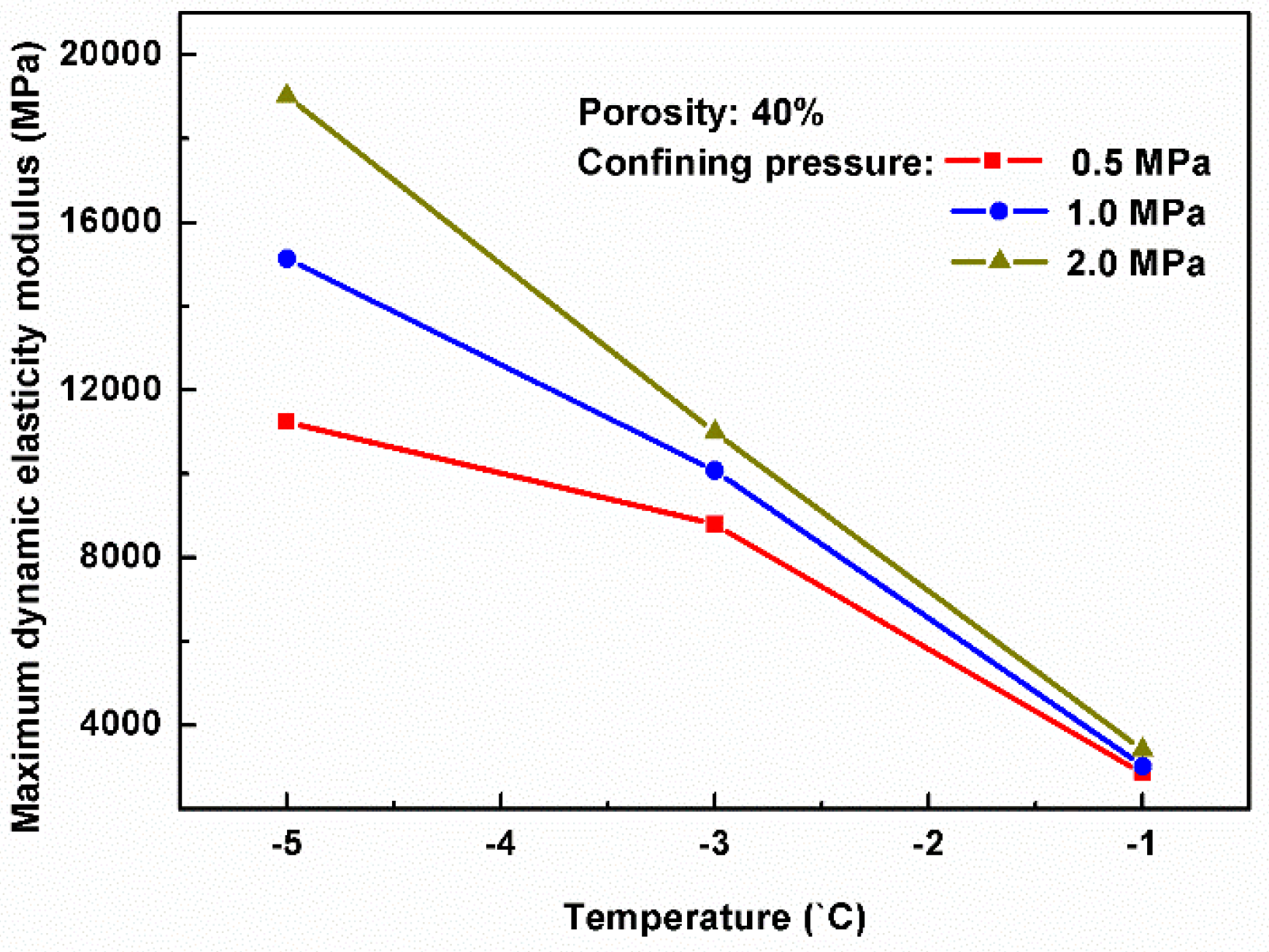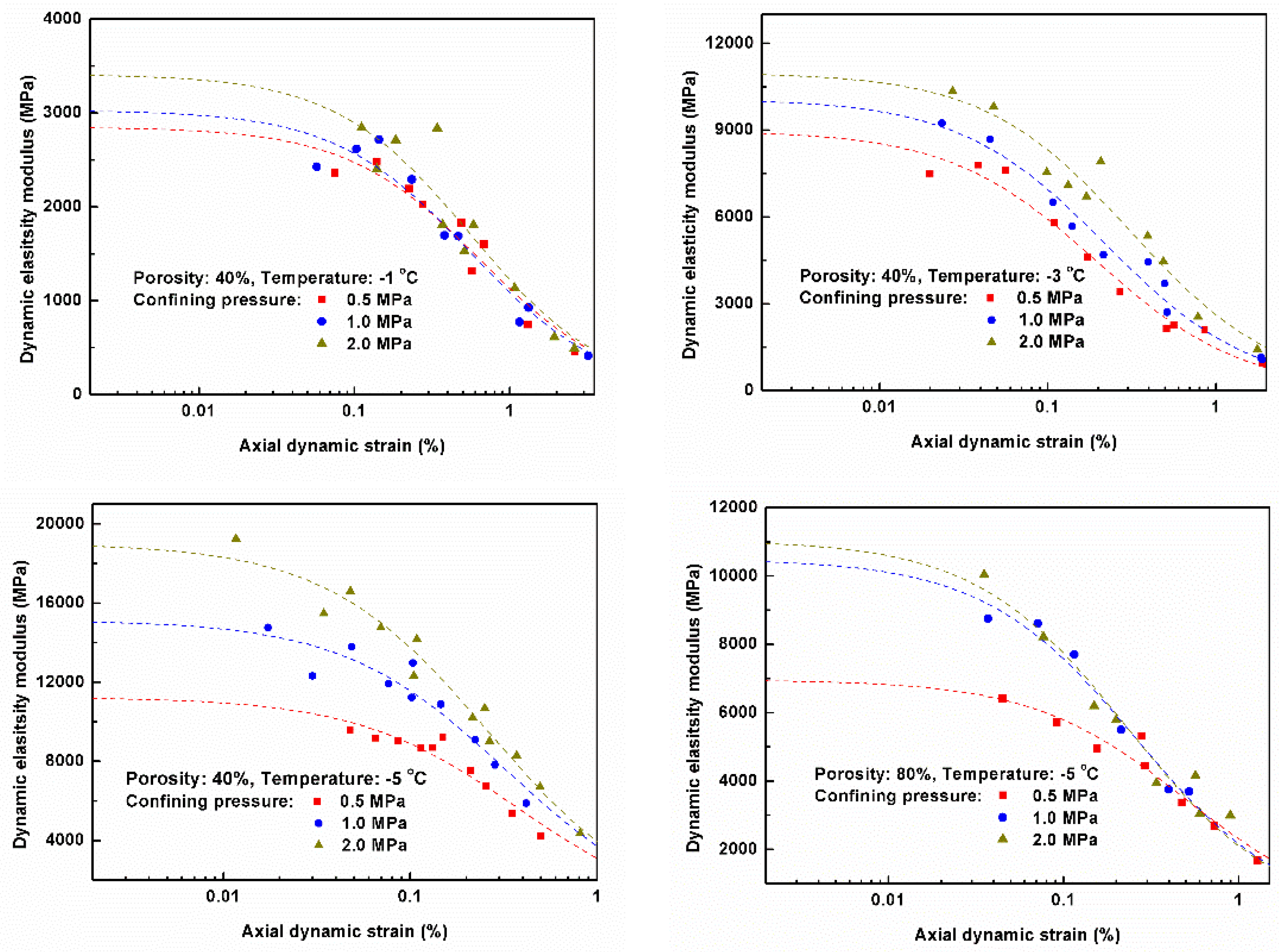Experimental Investigation on the Dynamic Modulus Properties of Methane Hydrate Sediment Samples
Abstract
1. Introduction
2. Experimental Methods and Procedures
2.1. Sample Preparation
2.2. Dynamic Loading Experimental Process
2.3. Experimental Conditions
3. Results and Discussions
3.1. The Relationship between Dynamic Stress and Strain
3.2. Skeleton Curves of Sediment Samples
3.3. The Maximum Dynamic Modulus of Elasticity
3.4. Dynamic Constitutive Model
4. Conclusions
- With an increase in the amplitude of dynamic loading applied to the sample, the hysteresis loops became more obvious on the dynamic stress–strain curves. In this case, the sediment’s deformation increased under the condition of the same number of vibrations, and finally the samples were destroyed by the dynamic loading.
- The temperature, confining pressure, porosity, and dynamic strain had significant effects on the dynamic elastic modulus of hydrate-bearing sediments. With increasing confining pressure, the maximum dynamic elastic modulus increased exponentially. With increasing porosity and higher temperatures, the sediment’s dynamic elastic modulus was softened. In addition, under the conditions of the same porosity, temperature and confining pressure, the values of a sediment’s dynamic elastic modulus were reduced with the increase in dynamic strain.
- The characteristics of the skeleton curves of hydrate-bearing sediments showed the same form as the stress–strain relationship under static triaxial compression. Elastic deformation was the main deformation mechanism in the initial phase, and then with the development of time, plastic deformation increased and elastic deformation decreased gradually.
- Based on the Hardin–Drnevich equivalent model, and combined with the dynamic modulus properties of sediments through dynamic loading experiments, an appropriate viscoelastic constitutive model was presented. Considering the influences of temperatures and confining pressures on the model parameters E and λ, the calculation formulas of elasticity modulus and damping ratio were modified. The computational results using this model were compared with experimental values, and the comparison of the results suggested that a good agreement was achieved.
Author Contributions
Funding
Acknowledgments
Conflicts of Interest
References
- Kvenvolden, K.A. A review of the geochemistry of methane in natural gas hydrate. Org. Geochem. 1995, 23, 997–1008. [Google Scholar] [CrossRef]
- Schultheiss, P.J.; Holland, M.; Humphreys, G.D. Borehole pressure coring and laboratory pressure core analysis for gas hydrate investigations. In Proceedings of the Offshore Technology Conference, Houston, TX, USA, 5–8 May 2008. [Google Scholar] [CrossRef]
- Yun, T.S.; Narsilio, G.A.; Santamarina, J.C.; Ruppel, C. Instrumented pressure testing chamber for characterizing sediment cores recovered at in situ hydrostatic pressure. Mar. Geol. 2006, 229, 285–293. [Google Scholar] [CrossRef]
- Makogon, Y.F.; Holditch, S.A.; Makogon, T.Y. Natural gas-hydrates-A potential energy source for the 21st Century. J. Pet. Sci. Eng. 2007, 56, 14–31. [Google Scholar] [CrossRef]
- Yang, L.; Ai, L.; Xue, K.H.; Ling, Z.; Li, Y.H. Analyzing the effects of inhomogeneity on the permeability of porous media containing methane hydrates through pore network models combined with CT observation. Energy 2018, 163, 27–37. [Google Scholar] [CrossRef]
- Mo, J.; Wang, W.H.; Peng, N.N.; Xu, C.D.; Zhang, D.Y. New progresses on marine geological survey-research in China. Geol. Surv. China 2019, 4, 85–91. [Google Scholar]
- Stern, L.A.; Kirby, S.H.; Durham, W.B. Polycrystalline methane hydrate: Synthesis from superheated ice, and low-temperature mechanical properties. Energy Fuel 1998, 12, 201–211. [Google Scholar] [CrossRef]
- Waite, W.F.; Winters, W.J.; Mason, D. Methane hydrate formation in partially water-saturated Ottawa sand. Am. Mineral. 2004, 89, 1202–1207. [Google Scholar] [CrossRef]
- Sun, X.; Luo, H.; Luo, T.T.; Song, Y.C.; Li, Y.H. Numerical study of gas production from marine hydrate formations considering soil compression and hydrate dissociation due to depressurization. Mar. Petrol. Geol. 2019, 102, 759–774. [Google Scholar] [CrossRef]
- Li, Y.H.; Liu, W.G.; Zhu, Y.M.; Chen, Y.F.; Song, Y.C.; Li, Q.P. Mechanical behaviors of permafrost-associated methane hydrate-bearing sediments under different mining methods. Appl. Energy 2016, 162, 1627–1632. [Google Scholar] [CrossRef]
- Sun, X.; Wang, L.; Luo, H.; Song, Y.C.; Li, Y.H. Numerical modeling for the mechanical behavior of marine gas hydrate-bearing sediments during hydrate production by depressurization. J. Pet. Sci. Eng. 2019, 177, 971–982. [Google Scholar] [CrossRef]
- Li, Y.H.; Song, Y.C.; Liu, W.G.; Yu, F. Experimental research on the mechanical properties of methane hydrate-ice mixtures. Energies 2012, 5, 181–192. [Google Scholar] [CrossRef]
- Masui, A.; Haneda, H.; Ogata, Y.; Aoki, K. The Effect of Saturation Degree of Methane Hydrate on the Shear Strength of Synthetic Methane Hydrate Sediments. In Proceedings of the Fifteenth International Offshore and Polar Engineering Conference, Seoul, Korea, 19–24 June 2005. [Google Scholar]
- Masui, A.; Haneda, H.; Ogata, Y.; Aoki, K. Mechanical Properties of Sandy Sediment Containing Marine Gas Hydrates in Deep Sea Offshore Japan. In Proceedings of the Seventh ISOPE Ocean Mining Symposium, Lisbon, Portugal, 1–6 July 2007. [Google Scholar]
- Masui, A.; Miyazaki, K.; Haneda, H.; Ogata, Y.; Aoki, K. Mechanical Characteristics of Natural and Artificial Gas Hydrate Bearing Sediments. In Proceedings of the Offshore Technology Conference, Houston, TX, USA, 5–8 May 2008. [Google Scholar]
- Miyazaki, K.; Masui, A.; Tenma, N.; Ogata, Y.; Aoki, K.; Yamaguchi, T. Study on mechanical behavior for methane hydrate sediment based on constant strain-rate test and unloading-reloading test under triaxial compression. Int. J. Offshore Polar Eng. 2010, 20, 61–67. [Google Scholar]
- Miyazaki, K.; Masui, A.; Sakamoto, Y.; Aoki, K.; Tenma, N.; Yamaguchi, T. Triaxial compressive properties of artificial methane-hydrate-bearing sediment. J. Geophys. Res. 2011, 116, 49. [Google Scholar] [CrossRef]
- Hyodo, M.; Yoneda, J.; Yoshimoto, N.; Nakata, Y. Mechanical and dissociation properties of methane hydrate-bearing sand in deep seabed. Soils Found. 2013, 53, 299–314. [Google Scholar] [CrossRef]
- Song, Y.C.; Zhu, Y.M.; Liu, W.G.; Zhao, J.F.; Li, Y.H.; Chen, Y.F.; Shen, Z.T.; Lu, Y.; Ji, C.M. Experimental research on the mechanical properties of methane hydrate-bearing sediments during hydrate dissociation. Mar. Pet. Geol. 2014, 51, 70–78. [Google Scholar] [CrossRef]
- Song, Y.C.; Zhu, Y.M.; Liu, W.G.; Li, Y.H.; Lu, Y.; Shen, Z.T. The effects of methane hydrate dissociation at different temperatures on the stability of porous sediments. J. Pet. Sci. Eng. 2016, 147, 77–86. [Google Scholar] [CrossRef]
- Liu, W.G.; Zhao, J.F.; Luo, Y.; Song, Y.C.; Li, Y.H.; Yang, M.J.; Zhang, Y.; Liu, Y.; Wang, D.Y. Experimental measurements of mechanical properties of carbon dioxide hydrate-bearing sediments. Mar. Petrol. Geol. 2013, 46, 201–209. [Google Scholar] [CrossRef]
- Liu, W.G.; Luo, T.T.; Li, Y.H.; Song, Y.C.; Zhu, Y.M.; Liu, Y.; Zhao, J.F.; Wu, Z.R.; Xu, X.H. Experimental study on the mechanical properties of sediments containing CH4 and CO2 hydrate mixtures. J. Nat. Gas Sci. Eng. 2016, 32, 20–27. [Google Scholar] [CrossRef]
- Waite, W.F.; Helgerud, M.B.; Nur, A.; Pinkston, J.C.; Stern, L.A.; Kirby, S.H.; Durham, W.B. Laboratory measurements of compressional and shear wave speeds through methane hydrate. Ann. N.Y. Acad. Sci. 2000, 912, 1003–1010. [Google Scholar] [CrossRef]
- Helgerud, M.B.; Waite, W.F.; Kirby, S.H.; Nur, A. Measured temperature and pressure dependence of Vp and Vs in compacted, polycrystalline s I methane and s II methane ethane hydrate. Can. J. Phys. 2003, 81, 47–53. [Google Scholar] [CrossRef]
- Winters, W.J.; Waite, W.F.; Mason, D.; Gilbert, L.Y.; Pecher, I.A. Methane gas hydrate effect on sediment acoustic and strength properties. J. Petrol. Sci. Eng. 2007, 56, 127–135. [Google Scholar] [CrossRef]
- Yun, T.S.; Francisca, F.M.; Santamarina, J.C.; Ruppel, C. Compressional and shear wave velocities in uncemented sediment containing gas hydrate. Geophys. Res. Lett. 2005, 32, 2607. [Google Scholar] [CrossRef]
- Lee, J.Y.; Francisca, F.M.; Santamarina, J.C.; Ruppel, C. Parametric study of the physical properties of hydrate-bearing sand, silt, and clay sediments: 2. Small-strain mechanical properties. J. Geophys. Res. 2010, 115, 6670. [Google Scholar] [CrossRef]
- Priest, J.A.; Best, A.I.; Clayton, C.R.I. Attenuation of seismic waves in methane gas hydrate-bearing sand. Geophys. J. Int. 2006, 164, 149–159. [Google Scholar] [CrossRef]
- Priest, J.A.; Rees, E.V.L.; Clayton, C.R.I. Influence of gas hydrate morphology on the seismic velocities of sands. J. Geophys. Res. 2009, 114, 6284. [Google Scholar] [CrossRef]
- Hu, G.W.; Ye, Y.G.; Zhang, J.; Liu, C.L.; Li, Q. Acoustic response of gas hydrate formation in sediments from South China Sea. Mar. Petrol. Geol. 2014, 52, 1–8. [Google Scholar] [CrossRef]
- Zhu, Y.M.; Li, Y.H.; Liu, W.G.; Song, Y.C.; Luo, T.T.; Wu, Z.R. Dynamic strength characteristics of methane hydrate-bearing sediments under seismic load. J. Nat. Gas Sci. Eng. 2015, 26, 608–616. [Google Scholar] [CrossRef]
- Li, Y.H.; Song, Y.C.; Liu, W.G.; Yu, F.; Wang, R. A new strength criterion and constitutive model of gas hydrate-bearing sediments under high confining pressures. J. Petrol. Sci. Eng. 2013, 109, 45–50. [Google Scholar] [CrossRef]
- Li, X.J.; Liao, Z.P.; Zhang, K.X. A functional formula of dynamic skeleton curve taking account of damping effect. Earthq. Eng. Eng. Vib. 1994, 14, 30–35. [Google Scholar]
- Chi, S.H.; Guo, X.X.; Yang, J.; Lin, G. Small strain characteristics and threshold strain of dynamic Hardin-Drnevich model for soils. Chin. J. Geotech. Eng. 2008, 30, 243–249. [Google Scholar]
- Yu, F.; Song, Y.C.; Li, Y.H.; Liu, W.G.; Lam, W.H. Analysis of stress-strain behavior and constitutive relation of methane hydrate-bearing sediments with various porosity. Int. J. Offshore Polar Eng. 2011, 21, 316–322. [Google Scholar]
- Mitchell, J.K.; Soga, K. Fundamentals of Soil Behavior, 3rd ed.; Wiley: Hoboken, NJ, USA, 2005. [Google Scholar]
- Yin, Z.Z. Geotechnical Principle; China Water and Power Press: Beijing, China, 2007. [Google Scholar]
- Kondner, R.L. Hyperbolic stress-strain response: Cohesive soils. J. Soil Mech. Found. Div. 1963, 89, 115–144. [Google Scholar]
- Hardin, B.O.; Drnevich, V.P. Shear modulus and damping in soils: Design equations and curves. J. Soil Mech. Found. Div. 1972, 98, 667–692. [Google Scholar]
- Zhou, J.; Bai, B.; Xu, J.P. Theory and Calculation of Soil Dynamic Mechanics; China Architecture and Building Press: Beijing, China, 2001. [Google Scholar]
- Li, S.Q. Discussion on delayed curve about soil viscoelasticity model. J. Liaoning Inst. Technol. 2004, 24, 58–60. [Google Scholar]










| Porosity (%) | Temperature (°C) | Confining Pressure (MPa) | Dynamic Loading Stages | Number of Cycles |
|---|---|---|---|---|
| 40 | −5 | 0.5, 1.0, 2.0 | 8~12 | 23 |
| −3 | ||||
| −1 | ||||
| 80 | −5 |
| Name and Unit | Value |
|---|---|
| c0 (MPa) | 0.3 |
| u (1/°C) | 0.149 |
| A (MPa) | 1304.63 |
| M0 | 1 |
| m | 78.78 |
| w (1/°C) | 0.58 |
| K0 (MPa) | 200 |
| k (MPa) | 1249.41 |
| a (1/°C) | 0.31 |
| pa (MPa) | 0.101 |
| n | 0.4 |
© 2019 by the authors. Licensee MDPI, Basel, Switzerland. This article is an open access article distributed under the terms and conditions of the Creative Commons Attribution (CC BY) license (http://creativecommons.org/licenses/by/4.0/).
Share and Cite
Zhang, X.; Zhu, Y.; Ying, Z.; Luo, T. Experimental Investigation on the Dynamic Modulus Properties of Methane Hydrate Sediment Samples. Energies 2019, 12, 4277. https://doi.org/10.3390/en12224277
Zhang X, Zhu Y, Ying Z, Luo T. Experimental Investigation on the Dynamic Modulus Properties of Methane Hydrate Sediment Samples. Energies. 2019; 12(22):4277. https://doi.org/10.3390/en12224277
Chicago/Turabian StyleZhang, Xudong, Yiming Zhu, Zhanfeng Ying, and Tingting Luo. 2019. "Experimental Investigation on the Dynamic Modulus Properties of Methane Hydrate Sediment Samples" Energies 12, no. 22: 4277. https://doi.org/10.3390/en12224277
APA StyleZhang, X., Zhu, Y., Ying, Z., & Luo, T. (2019). Experimental Investigation on the Dynamic Modulus Properties of Methane Hydrate Sediment Samples. Energies, 12(22), 4277. https://doi.org/10.3390/en12224277





